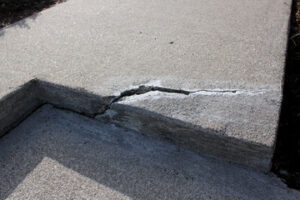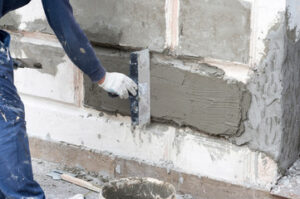Concrete is one of the most durable materials, but it can be damaged over time. Cracks and chips in concrete surfaces are unsightly and can also be a safety hazard, especially for children and elderly people.

Rather than replacing the whole surface, it is usually cheaper and easier to repair the damage. There are several steps involved in Concrete Repair Bismarck.
Concrete is a strong material, but it is not immune to damage over time. This damage can occur due to a number of reasons, including heavy loads, environmental factors, and settling. It is important to repair these issues promptly to prevent deterioration and protect the structural integrity of the structure. The correct method of repair will depend on the severity of the damage and the type of surface. There are two main types of concrete repair: structural and decorative. Structural repairs involve reinforcing the existing concrete to strengthen it, while decorative repairs address aesthetic concerns. Both require thorough preparation to ensure a long-lasting repair.
The first step in concrete repair is to clean the damaged surface thoroughly. This will remove any dirt, debris, or contamination that could inhibit the bond between the existing concrete and the repair material. The next step is to profile the concrete, which creates a rough surface that increases the mechanical bond between the repair material and the existing concrete. This can be done by shot blasting or acid etching, depending on the requirements of the project.
Once the surface is cleaned and profiled, it must be saturated to prepare it for placing the repair material. This can be done by saturating the concrete with water or using a wet material like a liquid coating. The concrete should be kept moist throughout the repair process, and must be allowed to cure according to the manufacturer’s instructions.
Materials
Using high-quality concrete repair materials is essential for making sure that your repairs last. The right products will help you avoid expensive replacement and keep your concrete surfaces strong and attractive. Whether you’re patching small cracks, resurfacing a damaged area, or sealing to prevent future problems, there are many different products available for every type of damage.
The first step in repairing concrete is to remove any loose material with a chisel and hammer. This will prepare the area for the patch and ensure that it bonds properly. In addition, it’s important to use protective equipment like gloves, safety glasses, and a dust mask when working with concrete.
If you’re repairing cracks, be sure to use a bond breaker to ensure that the new material stays in place. You can also add a chemical crack filler to the mix to reduce surface spalling and increase durability. It’s also important to use a crack repair material that matches the strength of the surrounding concrete and has a similar coefficient of thermal expansion.
For surface repair, it’s a good idea to use a textured concrete coating. This material can hide blemishes and improve traction, which is especially useful for high-traffic areas. A textured coating is also easy to clean and will withstand heavy wear and tear. For larger cracks, you can use a mortar mix that contains polymers to enhance adhesion and strength.
Tools
Concrete is a big investment for any homeowner, and it’s important to keep it in good condition. Cracking, chipping, or crumbling concrete surfaces can affect a home’s value and safety. It’s vital to repair these problems as soon as possible to prevent further deterioration and save money on costly repairs in the future. Fortunately, concrete repair is not as difficult as it may seem with the right tools and products.
To begin, it’s essential to clean the area to be repaired. This can be done by sweeping or using a pressure washer. Additionally, a wire brush can be used to remove any loose concrete from the surface. This will ensure that the patching materials bond properly with the existing concrete.
A hammer and chisel can also be used to break up the concrete and create a smooth surface for the patching material. It’s also a good idea to wear protective gear such as gloves, safety glasses, and a dust mask during the repair process. This will help protect against the toxic fumes created by some concrete resurfacing products.
Safety precautions
Whether you’re an experienced professional or a DIYer, safety is of the utmost importance when working with concrete. The right safety precautions can help you avoid costly mistakes, keep your project on track and prevent injuries to yourself or other workers. It’s also important to document your work, especially when it comes to larger structural repair projects. Visual documentation provides valuable information during the site assessment process, assists in instruction for future employees and enables you to compare previous results against the final result.
Before starting any concrete repairs, it’s essential to assess the severity of the damage. This will allow you to choose the best method and materials for your project. Surface damage may be caused by environmental factors such as weathering, heavy traffic or soil settlement. Chemical attacks from sulfates, chlorides and acids can also severely damage concrete, causing disintegration and weakening its strength.
After cleaning the damaged area, it’s important to apply a bonding agent to ensure that the repairing material adheres properly. You can also use a resurfacer to make the repaired area smooth and uniform with the surrounding concrete surface. It’s also vital to follow proper curing and finishing techniques to get the most out of your concrete repair.
Make sure that all workers have the appropriate personal protective equipment for working with concrete, including eye and face protection. In addition, make sure that a clear job description and training is provided for all workers who work with concrete. A well-organized workspace is also important to maintain a safe working environment.
Budget
Concrete repair is a complex task, and it can be difficult to estimate the costs. It is important to consider all of the factors involved in the process and plan accordingly. A professional contractor can assist in assessing the situation and recommending a course of action. This will help to avoid any surprises and ensure that the project is completed within budget.
Concrete surfaces are susceptible to damage from a variety of causes, including weathering and heavy foot traffic. These can result in cracks and spalling (flaking or peeling). Prompt repair is essential, as neglected concrete surface damage can lead to structural problems.
While it is possible to perform concrete leveling on your own, hiring a professional is recommended. This will save you time and money in the long run, as well as provide peace of mind. A professional will also use quality materials and products, ensuring that the results are guaranteed for many years.
The cost of concrete repair depends on the current state of the slab, as well as its location and extent of damage. For example, a small patch of spalling in an isolated area will be less costly than repairing extensive damage on an entire sidewalk. The type of resurfacing material used will also impact cost. Basic concrete overlays are usually the least expensive, while decorative options such as stamped or colored finishes are more expensive.
Professional help
Concrete is a strong and durable material that can hold up to many years of wear and tear. However, if it isn’t properly maintained, it can lose its integrity over time. This can lead to cracks, spalling, and discoloration. Luckily, there are several ways to fix these problems and keep them from getting worse.
To start with, a thorough visual inspection is necessary. Look for cracks, chips, and discoloration on the surface of the concrete. In addition, check for uneven surfaces and settlement issues that indicate deeper structural damage. It’s important to catch these issues as early as possible to minimize their impact.
A professional can assess the damage and determine the best repair method for your concrete. They can also recommend the proper materials and tools for the job. This will help ensure that the repairs are long-lasting. Furthermore, they can help you avoid costly mistakes that could make the problem worse.
Concrete repair can be a complex task, especially if it involves deep or extensive damage. It’s also a time-consuming project, so hiring a professional is a wise choice. A professional contractor will have the right tools and equipment to handle the project quickly and efficiently. They will also be able to identify any underlying issues that may need to be addressed before the concrete can be repaired properly. Additionally, they will have the proper safety gear and know how to follow safety protocols.
